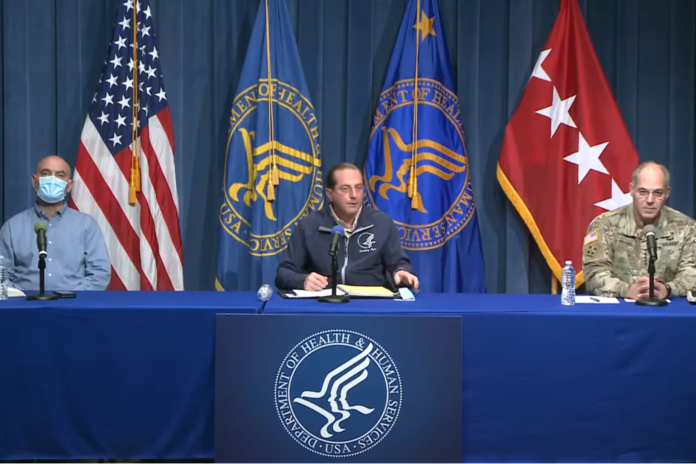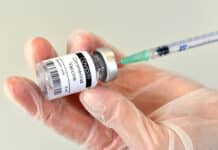
Operation Warp Speed (OWS) was born last May with aims “to have substantial quantities of a safe and effective vaccine available for Americans by January 2021.”
Mission accomplished? Depends upon whom you ask. That’s because negative reportage on the COVID-19 response is ad nauseam, instead of positive developments in fighting the pandemic or simple facts.
Prior to the release of high-efficacy vaccine results, the Atlantic published a “Vaccine Reality Check,” explaining that “a COVID-19 vaccine is unlikely to meet all high expectations;” CNBC told readers “a coronavirus vaccine cannot be reasonably expected until the end of 2021.”
The average vaccine takes about 10-15 years to develop, mostly due to red tape, and lower disease transmission within the community, which can delay efficacy results. Early investment by OWS paid dividends with approval of Pfizer and Moderna vaccines, along with nearly 40 million doses manufactured by the end of 2020; deployment followed just days after authorization.
The vaccines also needed strong logistics to avoid the notoriously sclerotic federal bureaucracy. So when OWS came under fire, as the number of doses administered lagged behind supply distribution, one could reason it was due to a bottleneck for giving shots.
The distribution of the vaccine to states went comparatively smoothly. OWS was created to develop, manufacture and distribute the doses, leaving coordination to state and local governments.
Discrepancies in vaccination efficiency vary widely among states, as a result of their decentralized nature. North Dakota and West Virginia lead the way in vaccine utilization. They avoided aforementioned bottlenecks by relying on a network of local, independent pharmacies that already had data for their patients. Amarillo, Texas, tops all cities in distribution.
Israel leads the world in vaccination rates, but among Western countries, the U.S. is far ahead of neighboring Canada and other nations. Dr. Moncef Slaoui, Gen. Gustave Perna, and former Health and Human Services Secretary Alex Azar deserve credit for their phenomenal approach to the pandemic.
Currently the U.S. awaits Phase III trial data from Johnson & Johnson’s one-dose coronavirus vaccine. Authorization should increase vaccination capacity, since the dose can be kept at normal refrigerated temps.
Moreover, case counts began declining Jan. 8 and vaccination rates continue to increase. From Dec. 23 to 30, an additional 1,581,100 first doses were administered. From Dec. 30 to Jan. 6, 2,717,682 additional first doses were administered, a 72% increase. Additionally, Moderna reported Monday they can neutralize the British and South African variants many are alarmed about.
In reporting on vaccination efforts, CNN played politics. First they quoted anonymous Biden officials claiming, “There is nothing for us to rework. We are going to have to build everything from scratch.” White House Chief of Staff Ron Klain claimed he was “inheriting a huge mess” last week and doubled down on Sunday.
These are lies that even Dr. Anthony Fauci contradicted last week.
Democrats long demanded we “not politicize” the vaccine development process, yet this is precisely what they are doing.
As the week of Jan. 25-29 closed, the CDC reports about 50 million doses of COVID-19 vaccines distributed around the U.S. and nearly 29 million administered. It would be impossible for this to occur if there was no distribution plan.
One million shots per day — as the new president seeks — is not an ambitious goal. We are already beating that mark, using the Trump administration playbook they ridiculed. And Biden’s recent “there’s nothing we can do to change the trajectory” line is misleading and unhelpful. He tried to clarify both yesterday and up his goals.
These erroneous claims insult the Department of Defense, UPS, FedEx, CVS, Walgreens, McKesson and Pfizer. All of these organizations have excelled in their roles in delivering vaccines to tens of millions of Americans. The U.S. now has vaccinated more citizens than any nation in the world.
Brian Harrison, former chief of staff at the U.S. Department of Health and Human Services, said when the last administration departed, they positioned approximately 250 million doses available by the end of Biden’s first 100 days. He also said HHS held over 300 transition meetings.
“Concerns about distribution and vaccine administration plans were never once raised to me by Biden representatives. Perhaps members of the Biden team are simply trying to lower expectations for themselves,” Harrison explained. “The truth is that they are neither starting ‘from scratch’ nor are they inheriting ‘a mess.’ I hope the Biden administration will build on — not disparage — the successes we left them. And when they identify areas for improvement, they should improve. That, as opposed to distortions and finger pointing, will speed our victory over COVID-19 and be a win for all Americans.”
With two vaccines lowering case and death rates each week, we enter a crucial phase. States must increase availability, so that distribution will continue at a rapid pace, hopefully making the inoculation available to everyone by this summer and eventually eradicating the plague from our lives.
A.J. Kaufman
A.J. Kaufman is an Alpha News columnist. His work has appeared in the Baltimore Sun, Florida Sun-Sentinel, Indianapolis Star, Israel National News, Orange County Register, St. Cloud Times, Star-Tribune, and across AIM Media Midwest and the Internet. Kaufman previously worked as a school teacher and military historian.

















